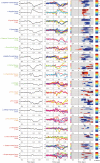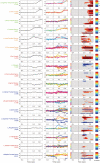Inter-individual variability in dorsal stream dynamics during word production
- PMID: 35997580
- PMCID: PMC9804493
- DOI: 10.1111/ejn.15807
Inter-individual variability in dorsal stream dynamics during word production
Abstract
The current standard model of language production involves a sensorimotor dorsal stream connecting areas in the temporo-parietal junction with those in the inferior frontal gyrus and lateral premotor cortex. These regions have been linked to various aspects of word production such as phonological processing or articulatory programming, primarily through neuropsychological and functional imaging group studies. Most if not all the theoretical descriptions of this model imply that the same network should be identifiable across individual speakers. We tested this hypothesis by quantifying the variability of activation observed across individuals within each dorsal stream anatomical region. This estimate was based on electrical activity recorded directly from the cerebral cortex with millisecond accuracy in awake epileptic patients clinically implanted with intracerebral depth electrodes for pre-surgical diagnosis. Each region's activity was quantified using two different metrics-intra-cerebral evoked related potentials and high gamma activity-at the level of the group, the individual and the recording contact. The two metrics show simultaneous activation of parietal and frontal regions during a picture naming task, in line with models that posit interactive processing during word retrieval. They also reveal different levels of between-patient variability across brain regions, except in core auditory and motor regions. The independence and non-uniformity of cortical activity estimated through the two metrics push the current model towards sub-second and sub-region explorations focused on individualized language speech production. Several hypotheses are considered for this within-region heterogeneity.
Keywords: HGA; fronto-parietal network; iERP; speech production; stereotactic electroencephalography.
© 2022 The Authors. European Journal of Neuroscience published by Federation of European Neuroscience Societies and John Wiley & Sons Ltd.
Conflict of interest statement
The authors declare they have no conflict of interest.
Figures








Similar articles
-
An intracerebral exploration of functional connectivity during word production.J Comput Neurosci. 2019 Feb;46(1):125-140. doi: 10.1007/s10827-018-0699-3. Epub 2018 Oct 13. J Comput Neurosci. 2019. PMID: 30317462
-
Three- and four-dimensional mapping of speech and language in patients with epilepsy.Brain. 2017 May 1;140(5):1351-1370. doi: 10.1093/brain/awx051. Brain. 2017. PMID: 28334963 Free PMC article.
-
Recording human electrocorticographic (ECoG) signals for neuroscientific research and real-time functional cortical mapping.J Vis Exp. 2012 Jun 26;(64):3993. doi: 10.3791/3993. J Vis Exp. 2012. PMID: 22782131 Free PMC article.
-
Dorsal and ventral streams: a framework for understanding aspects of the functional anatomy of language.Cognition. 2004 May-Jun;92(1-2):67-99. doi: 10.1016/j.cognition.2003.10.011. Cognition. 2004. PMID: 15037127 Review.
-
Controversy over the temporal cortical terminations of the left arcuate fasciculus: a reappraisal.Brain. 2022 May 24;145(4):1242-1256. doi: 10.1093/brain/awac057. Brain. 2022. PMID: 35142842 Review.
Cited by
-
Comparative analysis of four nuclei in the human brainstem: Individual differences, left-right asymmetry, species differences.Front Neuroanat. 2023 Feb 16;17:1069210. doi: 10.3389/fnana.2023.1069210. eCollection 2023. Front Neuroanat. 2023. PMID: 36874056 Free PMC article.
-
Assessing Functional Connectivity Dynamics During Cognitive Tasks Involving the Dorsal Stream.Entropy (Basel). 2025 May 27;27(6):566. doi: 10.3390/e27060566. Entropy (Basel). 2025. PMID: 40566153 Free PMC article.
References
-
- Arya, R. , Wilson, J. A. , Fujiwara, H. , Rozhkov, L. , Leach, J. L. , Byars, A. W. , Greiner, H. M. , Vannest, J. , Buroker, J. , Milsap, G. , Ervin, B. , Minai, A. , Horn, P. S. , Holland, K. D. , Mangano, F. T. , Crone, N. E. , & Rose, D. F. (2017). Presurgical language localization with visual naming associated ECoG high‐ gamma modulation in pediatric drug‐resistant epilepsy. Epilepsia, 663–673, 663–673. 10.1111/epi.13708 - DOI - PMC - PubMed
-
- Babajani‐Feremi, A. , Narayana, S. , Rezaie, R. , Choudhri, A. F. , Fulton, S. P. , Boop, F. A. , Wheless, J. W. , & Papanicolaou, A. C. (2016). Language mapping using high gamma electrocorticography, fMRI, and TMS versus electrocortical stimulation. Clinical Neurophysiology, 127(3), 1822–1836. 10.1016/j.clinph.2015.11.017 - DOI - PubMed

